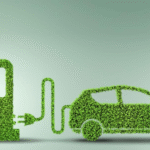The Impact of Government Incentives on EV Financing in India – It is hoped that these policies will notably contribute to India’s climate and sustainable development goals, create job opportunities and encourage innovation when they are implemented. By starting a more resilient and sustainable economy, the government is showing current problems and laying the foundation for future success. Electric vehicles (EVs) have been promoted as a way to lessen greenhouse gas emissions, improve air quality, and lessen India’s reliance on fossil fuels. However, a notable challenge to EVs’ wider acceptance has been their high innate expenses and the dearth of appropriate financing options. The government has given several incentives and programs to encourage the use of EVs to address this issue. The effect of these government incentives on the growth of the EV sector and how EV lenders in India might benefit from them will be explored in this blog post.

The Impact of Government Incentives
Scheme FAME II
The government’s flagship initiative, the Faster Adoption and Manufacturing of Hybrid and Electric Vehicles (FAME II) project, tries to encourage the nation’s EV acceptance. This program reduces the innate cost of buying an EV by providing financial incentives from the government to EV buyers. The market now provides a wider variety of EV financing solutions as a result of the scheme’s substantial contribution to the growth in EV demand.
GST Reduction
To promote EV adoption the Goods and Services Tax (GST) on EVs was lowered from 12% to 5% in 2019. Because EVs are now more affordable due to the GST drop, demand for EVs has risen. Due to the rising demand, EV customers now have access to a vast range of financing options, including contemporary finance methods such as battery leasing.
Infrastructure Subsidies for EV Charging
To encourage the usage of EVs, the government has also provided subsidies for EV charging structures. The government provides financial incentives to businesses and individuals that install EV charging stations under this program. As an outcome, there is now more infrastructure available for charging EVs, which has grown the demand.
State-Level Rewards
In India, a number of states have introduced their own EV incentives. For instance, Maharashtra provides a subsidy of up to Rs. 5,000 per kWh of EV battery capacity. In the same vein, Delhi overlooks all EV road taxes. The demand for EV financing solutions has enhanced as a result of these state-level incentives, which have been important in encouraging the adoption of EVs in their individual states.
Indian EV Government Initiatives | Obstacles And Rebuttals
Even though India’s government’s EV initiatives are worthy, some issues and concerns need to be addressed. They are as follows:
Insufficient Infrastructure for Charging
The lack of a strong and extensive infrastructure for charging EVs is one of the main challenges disrupting India’s smooth transition to electric vehicles. Convenient charging services are becoming increasingly essential as the number of electric vehicles on the road increases.
Excessive upfront expenses
Reducing operating and maintenance costs are clear signs of EVs’ long-term savings. Its higher starting cost compared to its internal combustion engine rivals is still a main turnoff, though. To mitigate this cost gap, the government has applied tax breaks, subsidies, and incentives. However, about 40% of customers are deterred from considering EVs as a possible solution due to the belief that they are expensive upfront investments.
Reliance on Component Imports
They have trouble producing necessary parts like batteries. Currently, 70% of the parts required to manufacture EVs are imported into India, which has an impact on the accessibility, affordability, and growth of the EV market. Therefore, starting a strong local supply chain for important EV components is important to getting competitive pricing and having a flourishing Indian EV market.
Power Generation Sustainability
Electricity sources are important to the operation of electric cars. This lifts questions over the entire environmental advantages of EV adoption in India, given that non-renewable resources like coal still account for 55% of the nation’s energy generation.
Therefore, moving to renewable energy sources is important for EVs to reach their full environmental possibility because the process of creating electricity may contribute to carbon emissions.
Conclusion
To sum up, government policies and incentives have been essential in encouraging the use of EVs in India. In addition to the growing demand for EVs, these incentives have extended the number of financing preferences available to EV purchasers. These government incentives can be utilized by EV lenders to present potential EV buyers with inviting financing choices. EV lenders may encourage the utilization of EVs and support the extension of the EV market in India by offering affordable financing solutions.
FAQs
How much of an impact do financial incentives have on sales of electric vehicles?
We discover that financial incentives and energy costs have a good impact on PEV adoption. Depending on the model parameters, the effect of incentives is approximated to increase market share by 5–7%.
What is the role of EVs in environmental sustainability?
Because they cut down on noise pollution, air pollution, and greenhouse gas emissions, electric vehicles (EVs) are important for environmental sustainability.
What impact does EV have on the world?
By 2035, EVs are hoped to make up between 6 and 8% of the world’s electricity usage. Protecting the electrical system is becoming more and more essential as the demand for electricity to charge electric vehicles grows.








